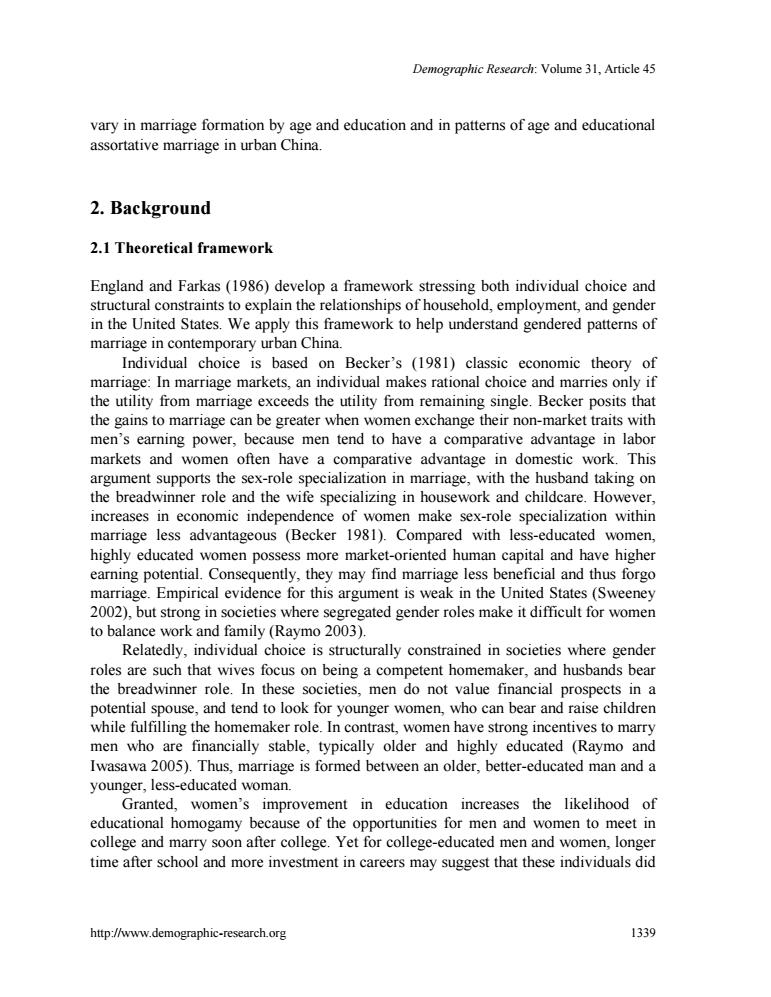正在加载图片...

Demographic Research:Volume 31,Article 45 vary in marriage formation by age and education and in patterns of age and educational assortative marriage in urban China. 2.Background 2.1 Theoretical framework England and Farkas (1986)develop a framework stressing both individual choice and structural constraints to explain the relationships of household,employment,and gender in the United States.We apply this framework to help understand gendered patterns of marriage in contemporary urban China. Individual choice is based on Becker's (1981)classic economic theory of marriage:In marriage markets,an individual makes rational choice and marries only if the utility from marriage exceeds the utility from remaining single.Becker posits that the gains to marriage can be greater when women exchange their non-market traits with men's earning power,because men tend to have a comparative advantage in labor markets and women often have a comparative advantage in domestic work.This argument supports the sex-role specialization in marriage,with the husband taking on the breadwinner role and the wife specializing in housework and childcare.However, increases in economic independence of women make sex-role specialization within marriage less advantageous (Becker 1981).Compared with less-educated women, highly educated women possess more market-oriented human capital and have higher earning potential.Consequently,they may find marriage less beneficial and thus forgo marriage.Empirical evidence for this argument is weak in the United States (Sweeney 2002),but strong in societies where segregated gender roles make it difficult for women to balance work and family (Raymo 2003). Relatedly,individual choice is structurally constrained in societies where gender roles are such that wives focus on being a competent homemaker,and husbands bear the breadwinner role.In these societies,men do not value financial prospects in a potential spouse,and tend to look for younger women,who can bear and raise children while fulfilling the homemaker role.In contrast,women have strong incentives to marry men who are financially stable,typically older and highly educated (Raymo and Iwasawa 2005).Thus,marriage is formed between an older,better-educated man and a younger,less-educated woman. Granted,women's improvement in education increases the likelihood of educational homogamy because of the opportunities for men and women to meet in college and marry soon after college.Yet for college-educated men and women,longer time after school and more investment in careers may suggest that these individuals did http://www.demographic-research.org 1339Demographic Research: Volume 31, Article 45 http://www.demographic-research.org 1339 vary in marriage formation by age and education and in patterns of age and educational assortative marriage in urban China. 2. Background 2.1 Theoretical framework England and Farkas (1986) develop a framework stressing both individual choice and structural constraints to explain the relationships of household, employment, and gender in the United States. We apply this framework to help understand gendered patterns of marriage in contemporary urban China. Individual choice is based on Becker‟s (1981) classic economic theory of marriage: In marriage markets, an individual makes rational choice and marries only if the utility from marriage exceeds the utility from remaining single. Becker posits that the gains to marriage can be greater when women exchange their non-market traits with men‟s earning power, because men tend to have a comparative advantage in labor markets and women often have a comparative advantage in domestic work. This argument supports the sex-role specialization in marriage, with the husband taking on the breadwinner role and the wife specializing in housework and childcare. However, increases in economic independence of women make sex-role specialization within marriage less advantageous (Becker 1981). Compared with less-educated women, highly educated women possess more market-oriented human capital and have higher earning potential. Consequently, they may find marriage less beneficial and thus forgo marriage. Empirical evidence for this argument is weak in the United States (Sweeney 2002), but strong in societies where segregated gender roles make it difficult for women to balance work and family (Raymo 2003). Relatedly, individual choice is structurally constrained in societies where gender roles are such that wives focus on being a competent homemaker, and husbands bear the breadwinner role. In these societies, men do not value financial prospects in a potential spouse, and tend to look for younger women, who can bear and raise children while fulfilling the homemaker role. In contrast, women have strong incentives to marry men who are financially stable, typically older and highly educated (Raymo and Iwasawa 2005). Thus, marriage is formed between an older, better-educated man and a younger, less-educated woman. Granted, women‟s improvement in education increases the likelihood of educational homogamy because of the opportunities for men and women to meet in college and marry soon after college. Yet for college-educated men and women, longer time after school and more investment in careers may suggest that these individuals did